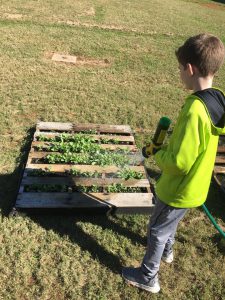 Over the past year, I’ve been contacted by several elementary and middle schools in Bartow County about starting school gardens! This is an exciting time in education as our local schools work toward becoming certified in Science, Technology, Engineering, and Math (STEM). Having a school garden is a natural extension of the classroom and gives our young people hands-on learning opportunities in the sciences. Young people are far more engaged with learning science when it can be applied to real-world situations like gardening or composting. I’ve always thought that every school should have a garden!
Over the past year, I’ve been contacted by several elementary and middle schools in Bartow County about starting school gardens! This is an exciting time in education as our local schools work toward becoming certified in Science, Technology, Engineering, and Math (STEM). Having a school garden is a natural extension of the classroom and gives our young people hands-on learning opportunities in the sciences. Young people are far more engaged with learning science when it can be applied to real-world situations like gardening or composting. I’ve always thought that every school should have a garden!
Starting a school garden doesn’t have to be a daunting task, but it does require some planning and forethought to be successful. The simplest concept is growing winter vegetables in wooden pallets. A pallet garden can be assembled by wrapping the base and sides with landscape fabric and attaching with a staple gun. Fill the pallet with store bought topsoil or compost and plant your seeds. The garden should be given an “all purpose” water soluble fertilizer once per week. This is a great math lesson for kids to determine the amount of fertilizer to dilute in water (read the label). They could also figure out the volume of soil needed to fill a pallet.
Winter vegetable transplants can be started indoors with zipper sandwich bags, cotton balls, and seeds. Moisten the cotton balls with water, stick a few seeds in the cotton ball, and seal them inside a sandwich bag. This will act like a miniature greenhouse by keeping the seeds from drying out. Write the names of the veggies on the bags and then tape them to a window with good light exposure. After about ten days, these seedlings will be ready to transplant into small starter pots with potting soil. Used milk cartons or paper cups work great for makeshift pots. Make sure there are drain holes in the bottom to let the water out. The cotton ball can be planted with the attached seedlings into the soil and will naturally decompose.
These starter plants can be grown indoors using LED or Florescent grow lights available at most hardware stores. A mechanical timer can also be used to plug into an outlet and automatically cycle the lights on and off for 14-16 hours each day. Hang the light as close to the plants as possible with a chain and adjust the height as the plants grow. An adjustable storage shelf works great for setting up the lights and ample space to grow transplants.
Winter vegetables can be planted in north Georgia both in the fall (September) and late winter (February). Transplants should be started indoors about six weeks prior to being moved outside to the garden. Most vegetables can be purchased as transplants from garden centers that are ready to go directly in the ground, if you don’t want to start your own seeds. Fast growing vegetables such as kale, mustard, radish, spinach, and turnips mature in 40 to 60 days after germination. Other cool-season vegetables may take 60 to 90 days to mature after germination.
You can direct seed the following cool-season vegetables of your choice: beets, carrots, lettuce, mustard, English peas, radishes, spinach, Swiss chard, and turnips. Thin plants when they are two to three inches tall to give the plants room to grow. For those cool-season vegetables that take longer to mature (such as cauliflower, broccoli, cabbage, Brussels sprouts, and collards), transplants might be advantageous for late winter planting. The key is giving them a jump-start on the season to keep them from bolting and going to flower as warm spring weather approaches. Also, many leafy greens will turn bitter if not harvested prior to the onset of warm weather.
As with all vegetables, try to select a garden site that receives at least eight to ten hours of sunlight per day. Select a location that is conveniently located near the house and a water supply. Many of the leafy greens such as Swiss chard, spinach, lettuce and kale can also be grown in patio containers or pallets due to their smaller size. Some of the ornamental Swiss chard varieties can provide a lot of color interest to mixed container plantings.
Because most cool-season vegetables grow close to the ground and have direct contact with the soil, you should avoid using fertilizer sources such as animal manure that could increase the chances of contamination with food-borne pathogens. Only use a chlorinated, municipal water source with these vegetables. Gray water sources and rain barrels can also be contaminated with pathogens that could make you sick. These non-potable water sources are fine for ornamental flowers, but not on vegetables you plan to eat.
Once you get comfortable with the process of starting seeds and growing a small container or pallet garden, then you can expand to more elaborate raised bed garden spaces. For schools, it’s a good idea to cover these gardens in the summer with plastic to put them in time out. This will avoid having to pull weeds or do any maintenance during summer break and allow you to start over each fall with a clean slate.
For more information, check out our UGA School Garden Resources website at https://t.uga.edu/5nN.
###
Paul Pugliese is the Extension Coordinator and Agricultural & Natural Resources Agent for Bartow County Cooperative Extension, a partnership of The University of Georgia, The U.S. Department of Agriculture, and Bartow County. For more information and free farm, lawn, or garden publications, call (770) 387-5142 or visit our local website at ugaextension.org/bartow.
